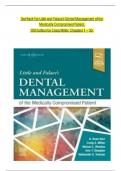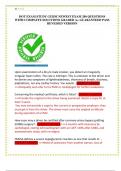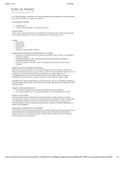Test Bank For Little and Falace's Dental Management of the
b b b b b b b b b
Medically Compromised Patient,
b b b
10th Edition by Craig Miller, Chapters 1 – 30.
b b b b b b b b
,Little: n Dental n Management n of n the n Medically n Compromised n Patient, n 10th n Edition n Test
n Bank
Table nof nContents
PART nONE: nPATIENT nEVALUATION nAND nRISK nASSESSMENT
Chapter n 1: n Patient n Evaluation n and n Risk n Assessment
PART nTWO: n CARDIOVASCULAR nDISEASE
Chapter n2: nInfective nEndocarditis
Chapter n3: nHypertension
Chapter n 4: n Ischemic n Heart n Disease
Chapter n5: nCardiac nArrhythmias
Chapter n6: nHeart nFailure n(or nCongestive nHeart nFailure)
PART n THREE: n PULMONARY n DISEASE
Chapter n 7: n Pulmonary n Disease
Chapter n 8: n Smoking n and n Tobacco n Use n Cessation
Chapter n9: nSleep-Related nBreathing nDisorders
PART n FOUR: n GASTROINTESTIAL n DISEASE
Chapter n10: nLiver nDisease
Chapter n11: nGastrointestinal nDisease
PART nFIVE: nGENITOURINARY nDISEASE
Chapter n12: nChronic nKidney nDisease nand nDialysis
Chapter n 13: n Sexually n Transmitted n Diseases
PART nSIX: nENDOCRINE nAND nMETABOLIC nDISEASE
Chapter n14: nDiabetes nMellitus
Chapter n15: nAdrenal nInsufficiency
Chapter n16: nThyroid nDiseases
Chapter n17: nPregnancy nand nBreast nFeeding
PART nSEVEN: nIMMUNOLOGIC nDISEASE
Chapter n 18: n AIDS, n HIV n Infection, n and n Related n Conditions
Chapter n19: nAllergy
Chapter n 20: n Rheumatologic n and n Connective n Tissue n Disorders
Chapter n21: n Organ nand n Bone n Marrow n Transplantation
PART nEIGHT: n HEMATOLOGIC n AND n ONCOLOGIC n DISEASE
Chapter n22: nDisorders nof nRed nBlood nCells
Chapter n23: nDisorders nof n White nBlood n Cells
Chapter n24: n Acquired n Bleeding nand n Hypercoagulable n Disorders
Chapter n25: nCongenital n Bleeding nand n Hypercoagulable nDisorders
Chapter n26: n Cancer n and n Oral n Care nof n the n Patient
PART nNINE: nNEUROLOGIC, nBEHAVIORAL, nAND nPSYCHIATRIC nDISORDERS
Chapter n27: nNeurologic nDisorders
Chapter n 28: n Anxiety, n Eating n Disorders, n and n Behavioral n Reactions n to n Illness
Chapter n29: nPsychiatric nDisorders
Chapter n30: nDrug nand n Alcohol nAbuse
, WWW.GRADESMORE.COM
Stuvia.com n- nThe nMarketplace nto nBuy nand nSell
nyour nStudy nMaterial
Chapter n01: nPatient nEvaluation nand nRisk nAssessment
Little: nDental nManagement nof nthe nMedically n Compromised nPatient, n10th nEdition
MULTIPLE n CHOICE
1. Elective ndental ncare nshould nbe ndeferred nfor npatients nwith nsevere, nuncontrolled
nhypertension, nmeaning n that n the n blood n pressure n is n greater n than n or nequal n to mm
nHg.
a. 200/140
b. n n n180/140
c. 180/110
d. n n n160/110
ANSWER: n C
Elective ndental ncare nshould nbe ndeferred nfor npatients nwith nsevere, nuncontrolled
nhypertension, nwhich nis nblood npressure ngreater nthan nor nequal nto n180/110 nmm nHg,
nuntil nthe ncondition ncannbe nbrought nunder ncontrol.
2. The n American n Heart n Association n currently n recommends n antibiotic n prophylaxis n for
n a n patientnwith nwhich nof nthe nfollowing ncardiac nconditions?
a. Mitral n valve n prolapse
b. Prosthetic n heart n valve
c. Rheumatic n heart ndisease
d. Pacemakers nfor ncardiac narrhythmias
ANSWER: n B
Previously, nthe nAmerican nHeart nAssociation n(AHA) nrecommended nantibiotic nprophylaxis
nfor nmany npatients nwith nheart nmurmurs ncaused nby nvalvular ndisease n(e.g., nmitral
nvalve nprolapse, nrheumatic nheart ndisease) n in nan neffort nto nprevent ninfective
nendocarditis; nhowever, ncurrent nguidelines nomit nthis nrecommendation non nthe nbasis
nof naccumulated nscientific nevidence. nIf na nmurmur nis ndue nto ncertain nspecific ncardiac
nconditions n(e.g., nprevious nendocarditis, nprostheticnheart n valve, n complex n congenital
n cyanotic n heart n disease), n the n AHA n continues n to n recommend nantibiotic
nprophylaxis nfor nmost ndental nprocedures.
3. One nconsequence nof nchronic nhepatitis n(B nor nC) nor ncirrhosis nof nthe nliver n is ndecreased
n ability nofnthe nbody nto certain ndrugs, nincluding nlocal nanesthetics nand nanalgesics.
a. absorb
b. distribute
c. metabolize
d. excrete
ANSWER: n C
Patients nalso nmay nhave nchronic nhepatitis n(B nor nC) nor ncirrhosis, nwith nimpairment
nof nliver nfunction. nThis ndeficit nmay nresult nin nprolonged nbleeding nand nless nefficient
nmetabolism nof ncertain ndrugs, nincluding nlocal nanesthetics nand nanalgesics.
4. Which nof n the n following n symptoms n and n signs n is n most n consistent n with n allergy?
a. Heart npalpitations
b. Itching
c. Vomiting
d. Fainting
WWW.NURSYLAB.COM
GRADESMORE.COM
, WWW.GRADESMORE.COM
Stuvia.com n- nThe nMarketplace nto nBuy nand nSell
nyour nStudy nMaterial
ANSWER: n B
Symptoms n and n signs n consistent n with n allergy ninclude n itching, n urticaria n (hives), n rash, n swelling,
nwheezing, nangioedema, nrunny nnose, nand ntearing neyes. nIsolated nsigns nand nsymptoms
nsuch nas nnausea, n vomiting, n heart n palpitations, n and n fainting n generally n are n not n of n an
n allergic n origin n but nrather nare nmanifestations nof ndrug nintolerance, nadverse nside neffects,
nor npsychogenic nreactions.
5. Which nof nthe nfollowing nis ntrue nof nthe npatient nwith na nhistory nof ntuberculosis?
a. A npositive n result n on n skin ntesting n means n that n the n person n has n active n TB.
b. Most n patients n who n become n positive n skin n testers n develop n active n disease.
c. Patients n with n acquired n immunodeficiency n syndrome n (AIDS) n have n a n high
n incidence n ofntuberculosis.
d. A ndiagnosis nof nactive nTB nis nmade nby na npurified nprotein nderivative n(PPD) nskin ntest.
ANSWER: C
The npotential ncoexistence nof ntuberculosis nand nacquired nimmunodeficiency nsyndrome
n(AIDS) nshould nbe nexplored nbecause npatients nwith nAIDS nhave na nhigh nincidence nof
ntuberculosis. nA npositive nresult non nskin ntesting nmeans nspecifically nthat nthe nperson nhas
nat nsome ntime nbeen ninfected nwith nTB, nnot nnecessarily nthat nactive ndisease nis npresent.
nMost npatients nwho nbecome npositive n skin n testers n do n not n develop n active n disease. n A
n diagnosis n of n active n TB n is n made n by n chestnx-ray, nimaging, nsputum nculture, nand
nclinical nexamination.
6. Vasoconstrictors n should n be n avoided n in n patients n who n cocaine n or
n methamphetamine n usersnbecause nthese nagents nmay nprecipitate .
a. severe nhypotension
b. severe nhypertension
c. respiratory ndepression
d. cessation nof n intestinal n peristalsis
ANSWER: n B
Vasoconstrictors n should n be n avoided n in n patients n who n are n cocaine n or
n methamphetamine n usersnbecause nthe ncombination nmay nprecipitate narrhythmias, nMI,
nor nsevere nhypertension.
7. It nhas nbeen nshown nthat nthe nrisk nfor noccurrence nof na nserious nperioperative
ncardiovascular nevent n(e.g., nMI, nheart nfailure) nis nincreased nin npatients nwho nare nunable
nto nmeet na n-MET n(metabolic nequivalent nof ntask) ndemand nduring nnormal ndaily
nactivity.
a. 4
b. 6
c. 8
d. 10
ANSWER: nA
Daily nactivities nrequiring n4 nMETs ninclude nlevel nwalking nat n4 nmiles/hour nor nclimbing na
nflight n of nstairs. n Activities n requiring n greater n than n 10 n METs n include n swimming n and n singles
n tennis. n An n exercisencapacity nof n10 nto n13 nMETs nindicates nexcellent nphysical
nconditioning.
8. Which n of n the n following n alterations n in n the n fingernails n is n associated n with n cirrhosis?
a. Yellowing
b. Clubbing
c. White ndiscoloration
WWW.NURSYLAB.COM
GRADESMORE.COM






